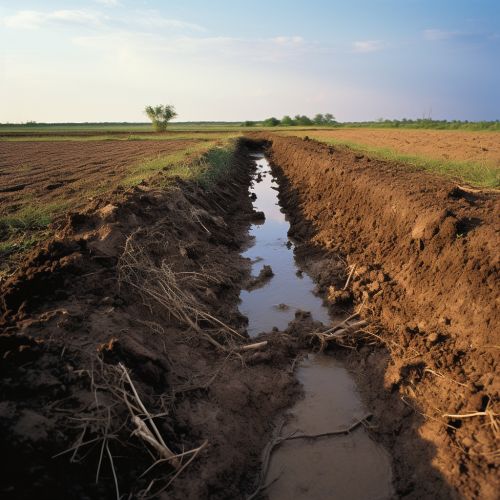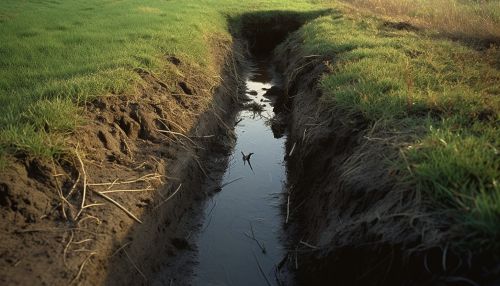Drainage
Overview
Drainage refers to the natural or artificial removal of a surface's water and sub-surface water from an area with excess of moisture. The internal drainage of most agricultural soils is good enough to prevent severe waterlogging (anaerobic conditions that harm root growth), but many soils need artificial drainage to improve production or to manage water supplies.
Importance of Drainage
Proper drainage is crucial for a variety of reasons. It helps to prevent the accumulation of stagnant water, which can lead to problems such as disease, flooding, and structural damage. In agriculture, effective drainage can increase productivity by providing a more suitable environment for plant growth. In urban areas, drainage systems are essential for managing the flow of rainwater and preventing flooding and water damage to infrastructure and property.
Types of Drainage
There are several types of drainage systems, each designed for a specific purpose. These include surface drainage, sub-surface drainage, slope drainage, and gutter systems.
Surface Drainage


Surface drainage is the removal of water that collects on the land's surface. This type of drainage is typically used in areas where water tends to pool on the surface, such as flat landscapes with heavy clay soil. Surface drainage systems often involve the creation of ditches or channels to carry away excess water.
Sub-Surface Drainage
Sub-surface drainage involves the removal of water from the root zone of the soil. This is typically achieved through the use of perforated pipes or tiles installed beneath the soil surface. Sub-surface drainage is often used in agricultural settings to improve the soil's water-holding capacity and to prevent waterlogging of crops.
Slope Drainage
Slope drainage is a method used to prevent water from accumulating on sloped surfaces. This is often achieved through the use of terraces, contour trenches, or other landscaping techniques designed to slow the flow of water and allow it to infiltrate the soil.
Gutter Systems
Gutter systems are a type of drainage system used on buildings to collect and divert rainwater away from the structure. Gutters are typically installed along the roof's edges and connected to downspouts that direct the water to the ground, away from the building's foundation.
Drainage Design
The design of a drainage system is a complex process that involves several factors. These include the type of soil, the topography of the land, the amount and frequency of rainfall, and the intended use of the land. The goal of drainage design is to create a system that effectively removes excess water from the area while minimizing negative impacts on the environment and surrounding land uses.
Drainage Maintenance
Regular maintenance is crucial for the effective operation of a drainage system. This can include tasks such as clearing debris from gutters and drains, inspecting and repairing damaged components, and monitoring the system's performance during and after rainfall events.
Environmental Impact
While drainage systems are essential for managing water, they can also have significant environmental impacts. These can include changes to natural water flow patterns, loss of wetland habitats, soil erosion, and water pollution from runoff carrying fertilizers, pesticides, and other contaminants.
